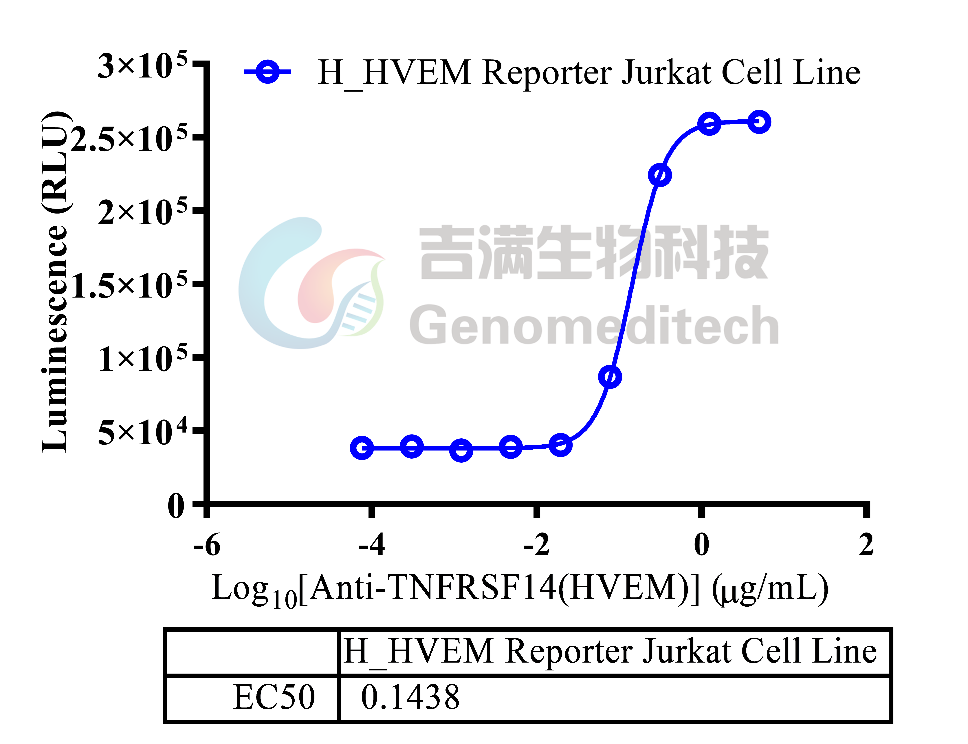Cat. No:GM-49928AB
Product:Anti-TNFRSF14(HVEM) hIgG4 Antibody
Cat. No:GM-49928AB
Product:Anti-TNFRSF14(HVEM) hIgG4 Antibody
GM-49928AB-10 10 μg
GM-49928AB-100 100 μg
GM-49928AB-1000 1mg
Species Reactivity Human
Clone /
Source/Isotype Monoclonal Human IgG4 /κ
Application Flow Cytometry; Activation assay
Specificity Detects TNFRSF14(HVEM)
Gene TNFSF15
Other Names ATAR, CD270, HVEA, LIGHTR, TR2
Gene ID 8764
Background Herpesvirus entry mediator (HVEM), also known as tumor necrosis factor receptor superfamily member 14 (TNFRSF14), is a human cell surface receptor of the TNF-receptor superfamily. The HVEM–LIGHT and HVEM–BTLA-CD160 network is a self-regulating ligand/receptor system that delivers bidirectional survival, proinflammatory and inhibitory signals to T cells, NKT cells and other immune cells. Under homeostatic (non-inflammatory) conditions, HVEM and BTLA interact in cis to provide an intrinsic inhibitory signal that modulates T-cell activation. Upon activation, T cells rapidly and transiently express membrane-bound LIGHT, which binds to and internalizes HVEM. Disruption of the HVEM–BTLA complex leaves BTLA available to signal in trans through HVEM present in neighboring cells. Therefore, after T-cell activation and during the course of T-cell differentiation, the expression of HVEM decreases, while that of BTLA increases. This allows BTLA and transiently expressed LIGHT in activated T cells to interact with HVEM in trans in surrounding cells and deliver bidirectional costimulatory signals. Ligand-induced oligomerization of HVEM leads to the recruitment of TRAF2 (TNF receptor-associated factor 2) and activation of downstream nuclear factor kappa B (NF-κB) in T cells and other immune cells.
Storage Store at 2-8℃ short term (1-2 weeks).Store at ≤ -20℃ long term. Avoid repeated freeze-thaw.
Formulation Phosphate-buffered solution, pH 7.2.
Endotoxin < 1 EU/mg, determined by LAL gel clotting assay



Cat. No:GM-49928AB
Product:Anti-TNFRSF14(HVEM) hIgG4 Antibody
GM-49928AB-10 10 μg
GM-49928AB-100 100 μg
GM-49928AB-1000 1mg
Species Reactivity Human
Clone /
Source/Isotype Monoclonal Human IgG4 /κ
Application Flow Cytometry; Activation assay
Specificity Detects TNFRSF14(HVEM)
Gene TNFSF15
Other Names ATAR, CD270, HVEA, LIGHTR, TR2
Gene ID 8764
Background Herpesvirus entry mediator (HVEM), also known as tumor necrosis factor receptor superfamily member 14 (TNFRSF14), is a human cell surface receptor of the TNF-receptor superfamily. The HVEM–LIGHT and HVEM–BTLA-CD160 network is a self-regulating ligand/receptor system that delivers bidirectional survival, proinflammatory and inhibitory signals to T cells, NKT cells and other immune cells. Under homeostatic (non-inflammatory) conditions, HVEM and BTLA interact in cis to provide an intrinsic inhibitory signal that modulates T-cell activation. Upon activation, T cells rapidly and transiently express membrane-bound LIGHT, which binds to and internalizes HVEM. Disruption of the HVEM–BTLA complex leaves BTLA available to signal in trans through HVEM present in neighboring cells. Therefore, after T-cell activation and during the course of T-cell differentiation, the expression of HVEM decreases, while that of BTLA increases. This allows BTLA and transiently expressed LIGHT in activated T cells to interact with HVEM in trans in surrounding cells and deliver bidirectional costimulatory signals. Ligand-induced oligomerization of HVEM leads to the recruitment of TRAF2 (TNF receptor-associated factor 2) and activation of downstream nuclear factor kappa B (NF-κB) in T cells and other immune cells.
Storage Store at 2-8℃ short term (1-2 weeks).Store at ≤ -20℃ long term. Avoid repeated freeze-thaw.
Formulation Phosphate-buffered solution, pH 7.2.
Endotoxin < 1 EU/mg, determined by LAL gel clotting assay


